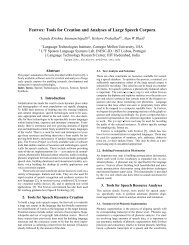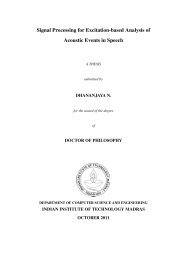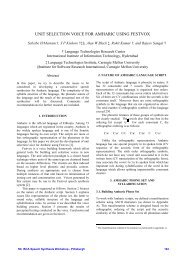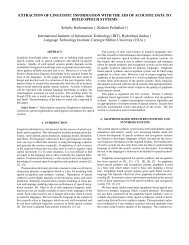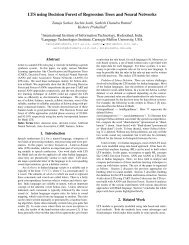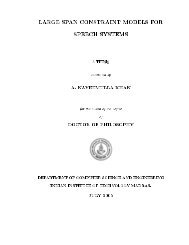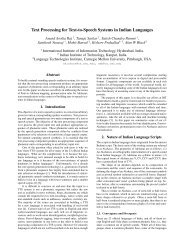word boundary- hypothesisation in hindi speech - Speech and ...
word boundary- hypothesisation in hindi speech - Speech and ...
word boundary- hypothesisation in hindi speech - Speech and ...
You also want an ePaper? Increase the reach of your titles
YUMPU automatically turns print PDFs into web optimized ePapers that Google loves.
were asked to identify the boundaries between the <strong>word</strong>s <strong>in</strong> the phrase. The results<br />
showed that the listeners were able to detect many <strong>word</strong> boundaries better than<br />
chance. An analysis of the resillts showed that stress <strong>and</strong> rhythm were the primary cues<br />
used by the listeners to detect worcl boundaries.<br />
Similar studies on the use ad prosodic cues were performed for other languages<br />
also. In a study on Japanese <strong>speech</strong> [Nakagawa <strong>and</strong> Sakai 19791, utterances of one to<br />
three <strong>word</strong> sequences of city naimes <strong>and</strong> digits was synthesised. When the voiced<br />
segments <strong>in</strong> the synthesised <strong>speech</strong> were replaced by s<strong>in</strong>usoids <strong>and</strong> the unvoiced<br />
segments by white noise with both pitch <strong>and</strong> energy unaltered, 95% of the <strong>word</strong><br />
boundaries <strong>in</strong> the sequences were still recognised by the listeners. When either energy<br />
or pitch is modified, the recognitioln rate dropped to 92%.<br />
In a later study [Lea 19801, an algorithm was developed to detect major<br />
syntactic boundaries <strong>in</strong> English <strong>speech</strong> us<strong>in</strong>g falllrise patterns <strong>in</strong> the pitch contour. The<br />
algorithm looks for substantial decreases <strong>in</strong> FO (7% or more) followed by an <strong>in</strong>crease<br />
(7% or more). It then marks a <strong>boundary</strong> at the last of the lowest FO values <strong>in</strong> the<br />
valley. Application of this algorithm on a data of 230 sentences, resulted <strong>in</strong> locat<strong>in</strong>g<br />
nearly 90% of the major syntactic boundaries correctly with false alarm rate between 5<br />
to 10%. In the same study it was suggested that some <strong>word</strong> boundaries can also be<br />
detected by us<strong>in</strong>g durational changes caused by 'prepausal lengthen<strong>in</strong>g'. It was also<br />
suggested that by detect<strong>in</strong>g pauses <strong>in</strong> <strong>speech</strong>, which occur as long silences, one can<br />
detect a few <strong>word</strong> boundaries.<br />
The relation between the prosody <strong>and</strong> the syntactic structure of a sentence was<br />
also exam<strong>in</strong>ed <strong>in</strong> some recent studies. It was shown that <strong>boundary</strong> tones, which are<br />
dist<strong>in</strong>ctive changes <strong>in</strong> pitch, signal major boundaries <strong>in</strong> phrases <strong>and</strong> sentences<br />
[Beckman <strong>and</strong> Pierrehumbert 19861. In a recent study, it was found that abrupt changes





